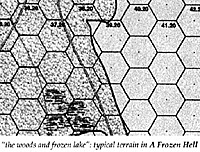The Winter War is one of those historical topics I had heard a little-but never knew much-about. I found working on Al Sandrick's A Frozen Hell a fascinating experience.
In my military time, I had twice been sent to Fort (then Camp) Ripley, Minnesota in January to learn about winter warfare techniques. We fell (literally) on skis, got leg cramps with snow shoes (I jumped out of a C-141 with snowshoes once-the amount of air they can catch coming out of a jet transport is pretty amazing, and what that force vector can do to a 19-year-old troop is pretty impressive as well), and did the whole arctic camo, arctic tent, arctic stove thing. Besides learning that bread toasted on the bare stove (mixed with various toxic oils found there) tasted much like buttered toast (no ill effects, yet) and that frost-bite really does, I found the information on the pace and techniques of winter fighting that I experienced there to be a big help in working on this game.
 "The woods and frozen lake": typical terrain in A Frozen Hell
"The woods and frozen lake": typical terrain in A Frozen Hell
I found the rough edges of Al's work to be (as usual) relatively easy to identify and smooth. I tried to consolidate the die rolls inserted at a few points, clarified some things, and learned quite a bit about the campaign and battle; Al's historical notes are of the highest caliber.
When the Soviets attacked Finland in late 1939, the 139th Rifle Division was sent on a flanking march against the Finn's 4th Corps. Defending the area was an ad hoc Task Force (rapidly being reinforced in strength as each day went by). The 139th made good progress until reaching the Tolvajdrvi area. Here, the newly appointed Finn commanders (Talvela and Pajari) took a stance of aggressive counterattack. They did this to not only raise their troops' morale, but to get operational dominance over the Russians. The series of battles they began, together with a few missteps by the Russians, caused the attack of the 139th to falter and turn into a withdrawal.
The Russians for their part are not quite as pathetic as seen in other Winter War games. They are outclassed by the Finns, of course, but I found them to be a more interesting and fun force than I expected. As you might think, you'll use mass and the bodies of peasants to make up for nimbleness and subtlety. The Russians have a great mass of power-it's just sluggish. At night, you'll find yourself hunkering down near the trails next to massive bonfires with the pesky Finns showing up for raids that might cause your troops to shoot each other up. Fear not, it is all in good fun, and your army will reorganize when the sun comes back up for the brief period laughingly called a "day."
The Finns bring ski movement to the table and have some nifty features available to make up for the disparity in numbers. You have a leader (Pajari) who can bolster morale an bring out a provisional infantry company when needed. You'll have the ability to launch some nice raid operations at night (with a special, fast Op Sheet implementation procedure to get you rolling), but limited firepower. You'll need to be fast on your feet to make things happen as needed.
The Finns also have a secret weapon: Field Kitchens. These things set up on the main trail leading off the battlefield and end up sucking in large numbers of hungry Russian troops looking for a warm meal. Don't laugh, historically an entire Russian regiment fell afoul of the lure of warm sausage (and the game has a little scenario to prove it).
Both sides can stumble into each other in ambushes. This happens because of the dense forest and sometimes terrible visibility (and many, many hours of night action).
Fighting on top of frozen lakes has some "issues" as well. Not only are these things billiard tables (not a whole lot of snow on the field during the battle), but artillery has this bad habit of blowing holes into it. Lots of fun there.
Key to the battlefield is a Hotel which can protect large numbers of troops. Look for some fierce fighting to take out this hex.
The Russians have some light tanks, but they did not play much of a role in the battle (your choices might be different). They are stuck, however, operating in platoon-size herds and tend to withdraw from the battle when they take losses unless they stack with a leader tank.
A Frozen Hell is a very different TCS game. It is an infantry fight on the order of Matanikau but without the unusual Japanese tactics and jungle. It does not have the open fields of, say, Black Wednesday, except on the lakes (which can be death traps during the day and under the rare illum round). I enjoyed the game as it matched my experience on skis and shivering on the tundra in Minnesota. War in the far north is a different animal. This game lets you see it.
Editor's Note: Those of you who want more historical
information about the battle of Tolvajdrvi and the Russo-Finnish
conflict in general should consider the Web site "The Battles of
Winter War" by Sami Korhonen.
http://www.winterwar.com/
http://www.winterwar.com/Battles/Tolvaj.htm
The site includes maps, photos, battle narratives, info on weapons, a discussion of tactics, orders of battle, and more. just examining the photos should put you in the right mood for the game. Brrr!
Back to Table of Contents -- Operations #39
Back to Operations List of Issues
Back to MagWeb Master List of Magazines
© Copyright 2000 by The Gamers.
This article appears in MagWeb (Magazine Web) on the Internet World Wide Web.
Other military history articles and gaming articles are available at http://www.magweb.com